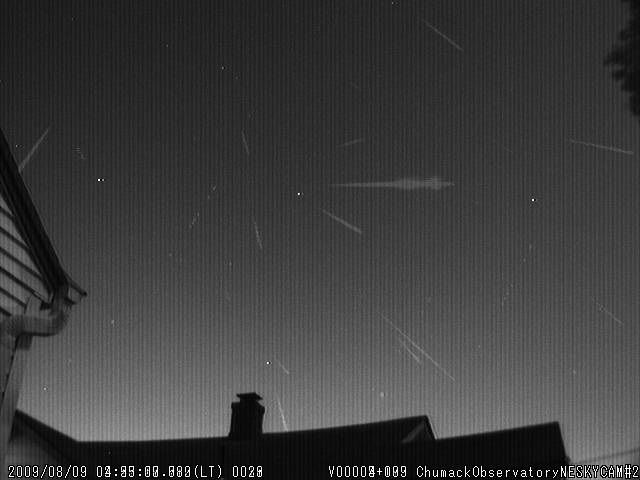

2009 Perseid Meteor Shower Preview by John Chumack
[/caption]
Are you ready for this year’s Perseid Meteor Shower? What will be the best place to watch and when will be the best date to see the most “shooting stars”? Follow along and let’s find out…
The Perseid meteor shower has a wonderful and somewhat grisly history. Often referred to as the “Tears of St. Lawrence” this annual shower coincidentally occurs roughly about the same date as the saint’s death is commemorated on August 10. While scientifically we know the appearance of the shooting stars are the by-products of comet Swift-Tuttle, our somewhat more superstitious ancestors viewed them as the tears of a martyred man who was burned for his beliefs. Who couldn’t appreciate a fellow who had the candor to quip “I am already roasted on one side and, if thou wouldst have me well-cooked, it is time to turn me on the other.” while being burned alive? If nothing else but save for that very quote, I’ll tip a wave to St. Lawrence at the sight of a Perseid!
While the fall rate – the number of meteors seen per hour – of the Perseids has declined in recent years since Swift-Tuttle’s 1992 return, the time to begin your Perseid watch is now. The random rate has already increased sharply and there is no guaranteed that skies will be clear on the predicted peak time – traditionally August 12 at approximately 11:00 GMT. The tears of St. Lawrence are already beginning to fall! Let’s join John Chumack via his Northeast Sky Camera #2 in his backyard Observatory in Dayton, Ohio, USA, for a look. This 5 hour movie was compressed to 10 seconds for web viewing.
Says John, “The brightest one occurred when the radiant was low on the horizon around 1:27 a.m. This fireball was at around -8 magnitude or greater, even with all the strong moonlight, some of the meteors are very bright! This one had a double explosion too!”
Astronomers are now estimating a double peak this year for viewers in the eastern portion of North America on Wednesday morning the 12th of August 2009. One peak should occur around 1:00 a.m. EST and the other peak around 5:30 a.m. EST. However, let’s assume that not all of us can be in that place and be up at that time… So let’s take a more practical look at observing the Perseid Meteor Shower.
Perseid meteor activity begins about midnight no matter where you live, but they can happen earlier, too. Because we are also contending with a Moon which will interfere with fainter meteors, the earlier you can observe, the better. There is no harm in beginning Tuesday night before the Moon rises. The general direction to face will be east around midnight and the activity will move overhead as the night continues. While waiting for midnight or later for activity to pick up to begin isn’t a pleasant prospect, by then we are looking more nearly face-on into the direction of the Earth’s motion as it orbits the Sun, and the radiant – the constellation of the meteor shower origin – is showing well. However, it won’t be long until the Moon also begins to show very well, indeed! Put an obstruction such as the edge of a house or a tree between you and Selene… Even if you just open an umbrella, the very act of shielding some of the light will most certainly help you to see far more meteors than if you don’t. For those of you who prefer not to stay up late? Try getting up early instead!
How many can you expect to see? A very average and cautiously stated fall rate for this year’s Perseids would be about 30 per hour, but remember – this is a collective estimate. It doesn’t mean that you’ll see one every two minutes, but rather you may see four or five in quick succession with a long period of inactivity in between. You can make your observing sessions far more pleasant by planning for inactive times in advance. Bring a radio along, a thermos of your favorite beverage, and a comfortable place to observe from. The further you can get away from city lights, the better your chances will be. If you’re cloud out on the peak date, don’t stop watching – because activity continues on for several days!
Will this 2000 year-old meteor shower be a sparkling success or a total dud? You’ll never know unless you go out and try yourself. One thing we do know is the Perseids are one of the most predictable of all meteor showers and even an hour or so of watching should bring a happy reward! Wishing you clear skies and good luck…
If you've ever looked at Mars through a telescope, you probably noticed its two polar…
Our Solar System is in motion and cruises at about 200 kilometres per second relative…
Late is better than never for the ‘Blaze Star’ T Coronae Borealis. It was on…
A planet's history is told in its ancient rock. Earth's oldest rocks are in the…
Data from the Chinese rover Zhurong is adding to the pile of evidence for oceans…
New information is pushing Asteroid 2024 YR4 off of our front pages. Initial estimates gave…